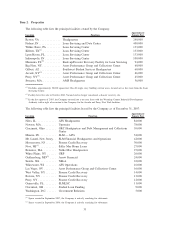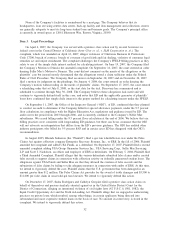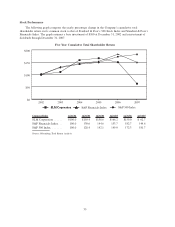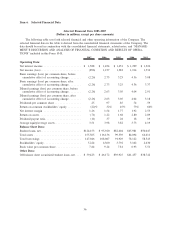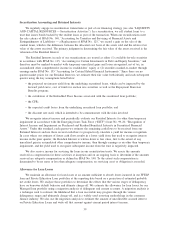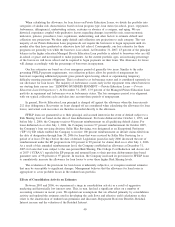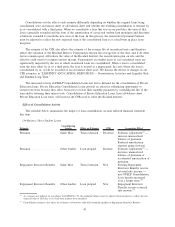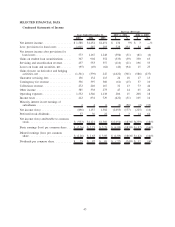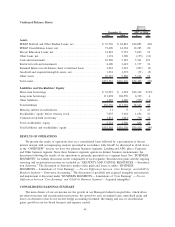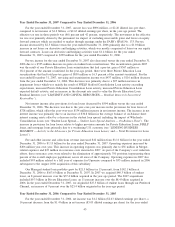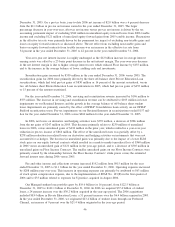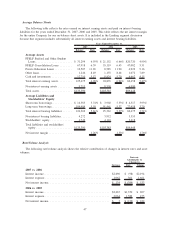Sallie Mae 2007 Annual Report Download - page 41
Download and view the complete annual report
Please find page 41 of the 2007 Sallie Mae annual report below. You can navigate through the pages in the report by either clicking on the pages listed below, or by using the keyword search tool below to find specific information within the annual report.When calculating the allowance for loan losses on Private Education Loans, we divide the portfolio into
categories of similar risk characteristics based on loan program type, loan status (in-school, grace, repayment,
forbearance, delinquency), underwriting criteria, existence or absence of a cosigner, and aging. We use
historical experience coupled with qualitative factors regarding changes in portfolio mix, macroeconomic
indicators, policies, procedures, laws, regulations, underwriting, and other factors to estimate default and
collection rate projections. We then apply default and collection rate projections to each category. The vast
majority of our Private Education Loan programs do not require the borrowers to begin repayment until six
months after they have graduated or otherwise have left school. Consequently, our loss estimates for these
programs are generally low while the borrower is in school. At December 31, 2007, 43 percent of the principal
balance in the higher education Managed Private Education Loan portfolio is related to borrowers who are still
in-school or grace and not required to make payments. As the current portfolio ages, an increasing percentage
of the borrowers will leave school and be required to begin payments on their loans. The allowance for losses
will change accordingly with the percentage of borrowers in repayment.
Our loss estimates are based on a loss emergence period of generally two years. Similar to the rules
governing FFELP payment requirements, our collection policies allow for periods of nonpayment for
borrowers requesting additional payment grace periods upon leaving school or experiencing temporary
difficulty meeting payment obligations. This is referred to as forbearance status and is considered separately in
our allowance for loan losses. The majority of forbearance occurs early in the repayment term when borrowers
are starting their careers (see “LENDING BUSINESS SEGMENT — Private Education Loans — Private
Education Loan Delinquencies”). At December 31, 2007, 13.9 percent of the Managed Private Education Loan
portfolio in repayment and forbearance was in forbearance status. The loss emergence period is in alignment
with our typical collection cycle and takes into account these periods of nonpayment.
In general, Private Education Loan principal is charged off against the allowance when the loan exceeds
212 days delinquency. Recoveries on loans charged off are considered when calculating the allowance for loan
losses, and actual cash recoveries are therefore recorded directly to the allowance.
FFELP loans are guaranteed as to their principal and accrued interest in the event of default subject to a
Risk Sharing level set based on the date of loan disbursement. For loans disbursed after October 1, 1993, and
before July 1, 2006, the Company receives 98 percent reimbursement on all qualifying default claims. For
loans disbursed on or after July 1, 2006, the Company receives 97 percent reimbursement. In October 2005,
the Company’s loan servicing division, Sallie Mae Servicing, was designated as an Exceptional Performer
(“EP”) by ED which enabled the Company to receive 100 percent reimbursement on default claims filed from
the date of designation through June 30, 2006 for loans that were serviced by Sallie Mae Servicing for a
period of at least 270 days before the date of default. Legislation passed in early 2006 decreased the rate of
reimbursement under the EP program from 100 percent to 99 percent for claims filed on or after July 1, 2006.
As a result of this amended reimbursement level, the Company established an allowance at December 31,
2005 for loans that were subject to the one-percent Risk Sharing. The College Cost Reduction and Access Act
of 2007 (“CCRAA”) repealed the EP program and returned loans to their previous disbursement date-based
guarantee rates of 98 percent or 97 percent. In reaction, the Company increased its provision for FFELP loans
to cumulatively increase the allowance for loan losses to cover these higher Risk Sharing levels.
The evaluation of the provisions for loan losses is inherently subjective, as it requires material estimates
that may be susceptible to significant changes. Management believes that the allowance for loan losses is
appropriate to cover probable losses in the student loan portfolio.
Effects of Consolidation Activity on Estimates
Between 2003 and 2006, we experienced a surge in consolidation activity as a result of aggressive
marketing and historically low interest rates. This, in turn, has had a significant effect on a number of
accounting estimates in recent years. We updated our assumptions that are affected primarily by consolidation
activity and updated the estimates used in developing the cash flows and effective yield calculations as they
relate to the amortization of student loan premiums and discounts, Repayment Borrower Benefits, Residual
Interest income and the valuation of the Residual Interest.
40



